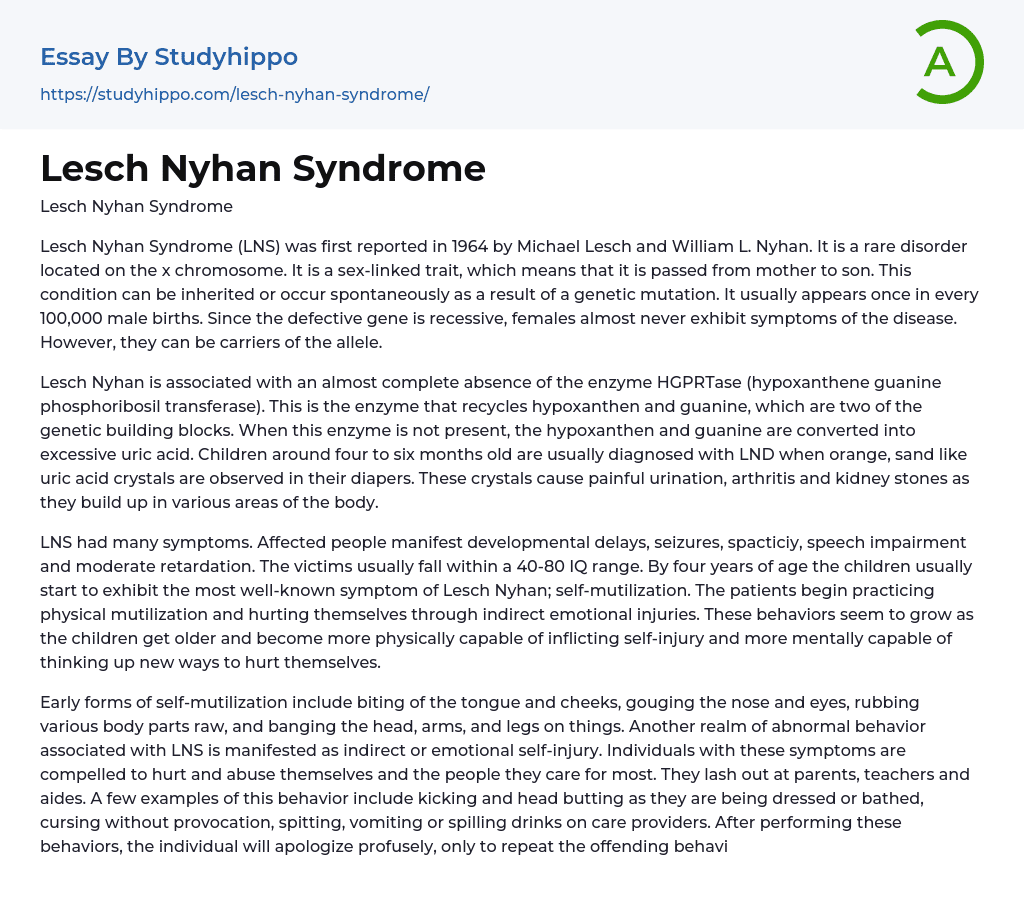Lesch Nyhan Syndrome (LNS), discovered in 1964 by Michael Lesch and William L. Nyhan, is a rare disorder found on the x chromosome. It can be inherited or occur spontaneously due to a genetic mutation. About one in every 100,000 male births is affected by this condition, while females are usually carriers of the gene without showing symptoms. LNS is characterized by a deficiency of the enzyme HGPRTase, responsible for recycling important genetic building blocks hypoxanthene and guanine. Without this enzyme, excessive uric acid is produced, leading to the formation of orange, sand-like crystals in infant diapers between four and six months old.
These crystals accumulate in different body parts causing painful urination, arthritis, and kidney stones. LNS presents several symptoms including developmental delays, seizures, spasticity, speech impairment, and moderate retardation. Most individuals with LNS have an IQ ran
...ging from 40-80. By age four, self-mutilization becomes apparent as a prominent symptom of LNS. Patients begin engaging in physical self-harm and indirectly emotionally harming themselves.
As children grow older and become more physically capable of hurting themselves and mentally capable of devising new ways to do so,
these behaviors tend to increase over time.
Initial forms of self-harm, such as biting the tongue and cheeks, poking the nose and eyes, rubbing body parts raw, and hitting the head, arms, and legs on objects, are observed in individuals with LNS. Another abnormal behavior associated with LNS is expressed through indirect or emotional self-harm. These individuals feel compelled to harm themselves and those they care about most. They may lash out at parents, teachers, and caregivers by kicking or headbutting during dressing or bathing, cursing without reason, spitting, vomiting, or intentionally spillin
drinks on their caregivers. After these actions, excessive apologies are made only to repeat the behaviors shortly after. Scientists recognize that these aggressive behaviors are indirect attempts at self-injury. Although they provoke others' anger and result in punishment or guilt for the offender; it should be understood that these actions are not meant to harm others but rather a way for individuals to harm themselves indirectly while experiencing consequences. For example: there was a case of a LN boy who enjoyed going to the movies but couldn't resist declining invitations from others which deprived him of enjoyment opportunities.
Unfortunately, there is currently no known cure or treatment for Lesch-Nyhan Syndrome (LNS). Physicians can only address the symptoms of the underlying disease. One notable treatment is Allopurinol therapy, where a daily dosage of 10-800mg is administered. This medication inhibits xanthine oxidase activity, resulting in decreased levels of uric acid and preventing muscular and skeletal symptoms. Lithotripsy can be an effective treatment option for kidney stones caused by "sandy urine". Other symptoms can be managed with medications such as carbidopa, levodopa, haloperidol, or phenobarbital. Unfortunately, there is no standardized treatment for the neurological symptoms of LNS.
The most appropriate approach for LNS patients is to utilize restraining devices. However, this differs from patients with other self-injuring behaviors since individuals with Lesch-Nyhan specifically request the use of restraints. They understand that without restraint, they inevitably harm themselves and become greatly distressed and fearful if left unguarded. While restraints are typically seen as restrictive, well-made protective devices are considered beneficial for LNS cases as they alleviate stress and fear regarding self-inflicted harm. Redirecting the patient's focus towards more constructive activities allows
them to effectively utilize their energyPatients can be taught to request restraining devices when they feel stressed, reducing the risk of self-harm. Trust in caregivers is crucial for the victim's safety, as loss of trust increases stress levels and self-injury frequency. Developing effective restraining devices remains a challenge to prevent further harm. Caregivers can use selective ignoring to regulate behaviors by not acknowledging harmful actions and continuing with normal activities. Facial expressions, retreat, reassurances, or punishment should be avoided as they reinforce unwanted behaviors. However, completely ignoring these behaviors may decrease their occurrence.In order to prevent self-inflicted injuries, measures must be taken for Lesch Nyhan (LN) individuals, such as filing or removal of their teeth and restraining their arms and legs while also clipping their nails short. Ongoing medical research projects focused on LN patients include a study conducted by Jeffery A. Carmen. Carmen tested the effectiveness of biofeedback equipment in controlling self-mutilating symptoms of LN by developing an electromyographic (EMG) monitor and relay box that can be connected to a video game or tape player. The apparatus was used on a young boy with LN to teach him how to control sudden muscle tension causing self-inflicted pain. Another proposed study aims to further this research as LN subjects occasionally experience periods of remission but typically do not survive beyond age four without allopurinol therapy. As LN patients grow older than ten or twelve years, therapy helps alleviate the severity of their symptoms, allowing them to survive until their twenties; however, it is common for them to succumb to infections or kidney failure during this stage.
- Dna essays
- Gene essays
- Cloning essays
- Medical Ethics essays
- Patient essays
- Therapy essays
- drugs essays
- Cannabis essays
- Aspirin essays
- Cardiology essays
- Hemoglobin essays
- Pharmacology essays
- Surgery essays
- alternative medicine essays
- Plastic Surgery essays
- Organ Donation essays
- Vaccines essays
- Medical essays
- Dentist essays
- Psychological Trauma essays
- Physical therapy essays
- Cold essays
- Cocaine essays
- Why Marijuana Should Be Legalized essays
- Drug Abuse essays
- Teenage Drug Abuse essays
- Heart Disease essays
- Artery essays
- Birth Control essays
- Drug Addiction essays
- Eating Disorders essays
- Epidemiology essays
- Hiv essays
- Hygiene essays
- Obesity essays
- Social Care essays
- Teenage Pregnancy essays
- Agriculture essays
- Albert einstein essays
- Animals essays
- Archaeology essays
- Bear essays
- Biology essays
- Birds essays
- Butterfly essays
- Cat essays
- Charles Darwin essays
- Chemistry essays
- Dinosaur essays
- Discovery essays




